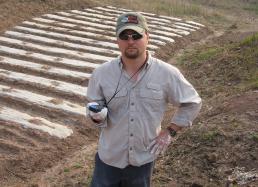1: En Route to Antarctica
This day of departure has finally arrived. It has been a long time coming, so long in fact that I had developed a habit of thinking about it as something that would happen in the distant future. Bill, Chris, Nate, and I originally submitted our grant proposal for work in the Central Transantarctic Mountains to the National Science Foundation (NSF) in early 2008, and waited a year to hear whether it was funded.
Although we got a positive response in 2009, we were informed that our field season would not happen until the end of 2010. In the meantime, life was filled with other events—my daughter was born in March of ‘09, my wife started a new job a few months later, we moved, I took on the responsibility of Chair of the Geology Department, and so forth. Even as preparations for this expedition have ramped up over the last few months, visiting Antarctica seemed somehow far off—until now.
Now I'm in a middle seat on a flight to Los Angeles, the first leg of a twenty-hour-plus journey to Christchurch, New Zealand, the gateway to Antarctica. Nate left Monday and was supposed to be at McMurdo already, but he's still stuck in Christchurch due to bad weather at McMurdo. Once there, we'll be issued cold weather gear, have our laptops checked for compatibility with NSF's network, and then deploy to Antarctica on a C17 Globemaster. But more on that later.
I am, of course, excited to be on my way, but it still feels surreal. I’ve been in this line of work for a decade, almost two if you count my graduate schooling, and I've collected fossils on three continents, occasionally in some pretty remote places (see Photo #1 below.) Yet all of them have been hot, dry, and with at least some human presence. Now I'll travel to one of the coldest places on Earth, where the only permanently inhabited settlements are a handful of scientific stations, all of them hundreds of miles from our remote camp. I have almost no idea what to expect.
Not so for my travelling companion Bill Hammer, who sits a few seat rows in front of me. This is Bill’s eighth expedition to that remote continent (see Photo #2 below)—in the airport he noted that he has been doing this for so long that PanAm was the carrier he would fly to New Zealand.
While we were catching up over a beer in the airport, I noted how hard it was to leave my wife and daughter for so long. At 20 months, my daughter is developing fast, and I know there will be a whole slew of ‘firsts’ I'll miss during my absence. On one of his early trips south, Bill also left his toddler son, who is now grown up and studying law. We know our absence will be hard on our families, and it's with a considerable feeling of guilt that I embark on this journey. In another twenty hours, I’ll add discomfort and a sore back to that.
Preparations for this trip have been going on for a long time. Early this year, the main grantees met in Chicago to put in our requests in to NSF for all the equipment and services we'll need, from personal items like clothes and tents, to equipment for fieldwork, including jackhammers, rock saws, generators, hand tools, and helicopter time. In August, we shipped off crates from Augustana College with more power tools and other bulky items like our mountaineering boots.
The long lead time is required because everything has to be brought by ship to McMurdo. In fact, the majority of supplies and equipment for the U.S. scientific missions in Antarctica arrive on one large cargo ship early in the Antarctic summer, which travels in the wake of an icebreaker that carves a path through the Ross Ice Shelf. In addition to equipment like ours, this shipment includes virtually all supplies needed for all the fixed and temporary labs and installations.
In the months since August, we've all undergone extensive medical exams to qualify for polar deployment. These included a battery of blood tests, which are required not only to ensure that people are healthy enough to go, but also to make sure that we can donate blood. There is no blood bank in Antarctica, so we're all asked to volunteer a transfusion should someone need it. There are also no dentists, and NSF does not want to have to fly someone back to civilization for a toothache, so they require a comprehensive dental check-up. All of our deployment logistics are handled by Raytheon on behalf of NSF’s Antarctic Program.
So now, I am finally en route to the last continent I've not yet visited. I’ll be in touch from New Zealand.
More soon,
Pete
P.S.: Be sure to check out the answers to the Frequently Asked Questions generated by the videos posted last week!



